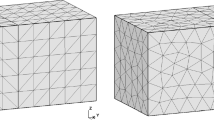Abstract
The Nedelec edge elements are now widely used for numerical analysis of various electromagnetic problems. However, it has not been easy to show their mathematical validity since the formulations associated with the edge elements are usually based on some mixed variational principles on special function spaces. In particular case of the simplest Nedelec simplex elements, the present author formerly showed the discrete compactness which plays essential roles in theoretical analysis of such elements. Here we present some new results on such a property for more general edge elements using an approach slightly different from that employed by Boffi to obtain results on the same subject.
Similar content being viewed by others
References
R.A. Adams, Sobolev Spaces. Academic Press, 1975.
C. Amrouche, C. Bernardi, M. Dauge and V. Girault, Vector potentials in three-dimensional non-smooth domains. Math. Meth. Appl. Sci.,21 (1998), 823–864.
D. Boffi, Fortin operator and discrete compactness for edge elements. Numer. Math.,87 (2000), 229–246.
D. Boffi, P. Fernandes, L. Gastaldi and I. Perugia, Computational models of electromagnetic resonators: analysis of edge element approximation. SIAM J. Numer. Anal.,36 (1999), 1264–1290.
A. Bossavit, Computational Electromagnetism: Variational Formulations, Complementary, Edge Elements. Academic Press, 1998.
C. Brenner and L.R. Scott, The Mathematical Theory of Finite Element Methods. Springer-Verlag, 1994.
F. Brezzi and M. Fortin, Mixed and Hybrid Finite Element Methods. Springer-Verlag, 1991.
S. Caorsi, P. Fernandes and M. Raffetto, On the convergence of Galerkin finite element approximations of electromagnetic eigenproblems. SIAM J. Numer. Anal.,38 (2000), 580–607.
S. Caorsi, P. Fernandes and M. Raffetto, Approximation of electromagnetic eigenproblems: a general proof of convergence for edge finite elements of any order of both Nedelec’s families. CNR-IMA, Technical Report No. 16/99, Genova, Italy, 1999.
P.G. Ciarlet, The Finite Element Method for Elliptic Problems. North-Holland, 1978.
M. Costabel and M. Dauge, Maxwell and Lamé eigenvalues on polyhedra. Math. Meth. Appl. Sci.,22 (1999), 243–258.
G. Duvault and J.-L. Lions, Inequalities in Mechanics and Physics. Springer-Verlag, 1976.
J. Descloux, N. Nassif and J. Rappaz, On spectral approximation. Part 2. Error estimates for the Galerkin method. RAIRO, Analyse Numerique,12 (1978), 113–119.
P. Fernandes and M. Raffetto, The question of spurious modes revisited. Int. Compumag Soc. Newsletter,7, No. 1 (2000), 5–8.
V. Girault and P.-A. Raviart, Finite Element Methods for Navier-Stokes Equations. Springer-Verlag, 1986.
P. Joly, C. Poirier, J.E. Robert and P. Trouve, A new nonconforming finite element method for the computation of electromagnetic guided waves I: mathematical analysis. SIAM J. Numer. Anal.,33 (1996), 1494–1525.
F. Kikuchi, Mixed and penalty formulations for finite element analysis of an eigenvalue problem in electromagnetism. Computer Meth. Appl. Mech. Engng.,64 (1987), 509–521.
F. Kikuchi, On a discrete compactness property for the Nedelec finite elements. J. Fac. Sci., Univ. Tokyo, Sect. IA Math.,36 (1989), 479–490.
F. Kikuchi, Weak formulations for finite element analysis of an electromagnetic eigenvalue problem. Sci. Papers of Coll. Arts & Sci., The Univ. Tokyo,38 (1988), 43–67.
F. Kikuchi, Discrete compactness of the linear rectangular Nedelec element. Abstracts of Presentations at 1999 Spring Meeting of Math. Soc. Japan, 1999, 108–111.
F. Kikuchi, Theoretical aspects of Nedelec’s edge elements applied to electromagnetic problems. ICIAM ’99. Proceedings of the 4th International Congress on Industrial and Applied Mathematics (eds. J.M. Ball and J.C.R. Hunt), Oxford University Press, 2000.
F. Kikuchi and M. Fukuhara, An iterative method for finite element analysis of magnetostatic problems. Advances in Numerical Mathematics (eds. T. Ushijima, Z.-C. Shi and T. Kako), Kinokuniya, 1995, 93–105.
F. Kikuchi, M. Yamamoto and H. Fujio, Theoretical and computational aspects of Nedelec’s edge elements for electromagnetics. Computational Mechanics — New Trends and Applications (eds. E. Oñate and S.R. Idelsohn), © CIMNE, Barcelona, Spain, 1998.
J.-C. Nedelec, Mixed finite elements in R3. Numer. Math.,35 (1980), 315–341.
J.-C. Nedelec, A new family of mixed finite elements in R3. Numer. Math.,50 (1986), 57–81.
P.P. Silvester and R.L. Ferrari, Finite Elements for Electrical Engineers (3rd edn.). Cambridge Univ. Press, 1996.
Author information
Authors and Affiliations
Corresponding author
About this article
Cite this article
Kikuchi, F. Theoretical analysis of Nedelec’s edge elements. Japan J. Indust. Appl. Math. 18, 321–333 (2001). https://doi.org/10.1007/BF03168578
Received:
Revised:
Issue Date:
DOI: https://doi.org/10.1007/BF03168578




